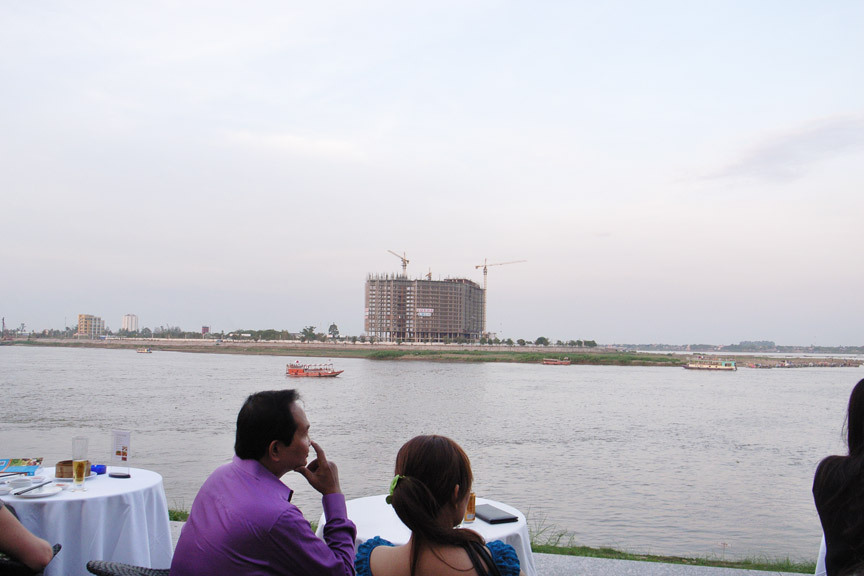Compared to many of its regional neighbors, Phnom Penh still retains an urban landscape built on human scale. However, as residents and visitors enjoy the breeze while watching fishing boats float by on the banks of the Mekong, Tonle Sap and Bassac rivers, certain "progress"—not necessarily for the betterment of the city—seems inevitable.
In front of the oldest, independent nonprofit art space in Cambodia: Reyum Institute of Arts and Culture founded in 1998. Ahead of its time, Reyum has organized talks and exhibitions, published books and hosted art courses on both the traditional and contemporary arts of Cambodia. It has been closed for renovations for the last two years, but Reyum will soon resume their activities that lie at the heart of the Cambodian artistic and intellectual community.
Archival material from “Seams of Change,” a past exhibition held in 2004 at Reyum on clothing in late 19th- and 20th-century Cambodia.
Reyum co-founder Daravuth Ly shows us a traditional silk dress still worn today by women in the Cambodian countryside.
More archival material from previous Reyum exhibitions: old architectural drawings of mosques in Cambodia.
While Reyum is a non-collecting arts organization, they have a small personal collection of paintings by one of Cambodia’s most important painters, the late Svay Ken (1933–2008). The works were made as an homage to Reyum’s co-founding director, Ingrid Maun (1964–2005), who was a nurturing figure to Ken.
Directly across the street from Reyum is Cambodia’s official art school, the Royal University of Fine Arts (RUFA). It offers courses in traditional art making such as bronze casting and weaving as well as painting, drawing and sculpture. Many students also attend RUFA to study archeology, architecture, theatre and music.
Down the road from Reyum is the National Museum of Cambodia, with a world-class collection of Khmer art, including magnificent sculptures from Angkor Wat. Although the museum itself was built between 1917–1920 during the French colonial period, its tiered roofs and spires are considered superb examples of classical Khmer monumental architecture. Families of bats have also made the National Museum their home for many years.
At the National Museum of Cambodia, could that be a modern, minimalist stone sculpture? No, actually it’s a Khmer lingam and yoni.
Leang Seckon, one of the most active artists in Cambodia, explains his art making process, which includes explorations of Buddhism, depictions of his family’s story of surviving the Khmer Rouge, and drawing, painting and collage, pieced together to create narrative-style works. He has also recently shifted his attention to environmental issues that have begun to affect Cambodia due to increases in factory production and other forms of industrialization.
Leang’s mother is often the subject of many of his paintings, collages and sculptures. Here she sits with calm dignity in his studio.
Leang’s nephew Lim Sokchanlina is a young photographer who is a founding member of the arts collective Stiev Selapak, or “art rebels,” which established the contemporary art space Sa Sa Art Projects in 2010. A year later they forged ties with the contemporary gallery Bassac Art Projects. Today the space is now called Sa Sa Bassac, and Lim here leads us to one of the most contemporary galleries supporting young Cambodian artists.
Artist Than Sok installing his exhibition “The Halo of the Omnipresent Eye” with gallery curator and director Erin Gleeson. The exhibition features an installation that explores the practice of supplication for alms in Buddhist monkhood.
Java Café & Gallery is one of the oldest commercial galleries in the capital, founded in 2000 by Dana Langlois. It serves coffee, sandwiches, pastries and wifi in addition to mounting exhibitions by Cambodian and expatriate artists.
Meta House Phnom Penh, established in 2007 by German filmmaker Nico Mesterharm, also attracts both the local and expat crowd with their regular film screenings and exhibitions. It has forged links with the Goethe-Institut and offers German courses.
Meta House held an exhibition of artist Chhim Sothy, a graduate of the Royal University of Fine Arts, revered in the local art scene for both his representational and abstract paintings.
Bophana Audiovisual Resource Center, founded in 2006 by Cambodia’s leading film director and screenwriter Rithy Panh and fellow filmmaker Leu Pannakar, is both a film archive as well as a screening, research and exhibition center. The mission of Bophana is clear and simple: “The project of collecting the Cambodian audiovisual heritage is to create an access to memory, to remember, to transmit a history and a culture to future generations and this to initiate a better future.”
Bophana was named after one of Panh’s docudramas “Bophana: A Cambodian Tragedy” (1996) based on the true story of Hout Bophana, a 25-year old young woman, who was sent to Security Prison 21 (S-21) in Phnom Penh to be tortured and killed for writing love letters to her husband.
Among those who have come to visit Bophana include Hollywood filmmaker Oliver Stone.
In the large studio of Sopheap Pich. Known internationally for his rattan and bamboo sculptures, Sopheap left Cambodia with his family in 1984, only to return 20 years later. He has developed a unique style of green, organic, architectural sculptures that have been exhibited in locations such as New York, Brisbane, Fukuoka, Singapore, Thuwal (Saudi Arabia) and most recently at MASS MoCA in Massachusetts, USA.




